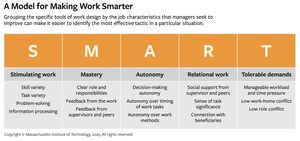CAMBRIDGE, Mass., Dec. 12, 2023 /PRNewswire/ -- According to a new article in MIT Sloan Management Review, AI's potential contributions to solving the climate crisis may be overshadowed by its enormous energy use and carbon emissions, e-waste, and water use.
A single ChatGPT query can generate 100 times more carbon than a regular Google search. Training OpenAI's GPT-3 model is estimated to have used the equivalent of 120 average U.S. households' annual energy consumption. An average data center, critical infrastructure for AI, consumes the equivalent of heating 50,000 homes yearly. Microsoft and Google's use of water to cool data centers has grown by millions of gallons as they develop cutting-edge AI technologies.
"Several factors contribute to the carbon footprint of AI systems throughout their life cycles," explains Niklas Sundberg, author of the article, "Tackling AI's Climate Change Problem." "The AI industry must adopt practices that emphasize sustainability, make sustainability central to its AI ethics guidelines, and actively seek opportunities to reduce the environmental footprint of AI technologies."
Sundberg, a board member of SustainableIT.org and chief digital officer at Kuehne+Nagel, a global transport and logistics company, urges that transparency is critical. Reliable measurements of new models' energy use and carbon emissions must be published to raise awareness and encourage AI developers to compete on model sustainability. End users must also be aware of the factors that contribute to the environmental impacts of these tools to guide their use of them and add sustainability to the list of criteria they use to evaluate vendors and products.
In "Tackling AI's Climate Change Problem," Sundberg details the best practices for sustainable AI, which include the three R's: relocate, rightsize, and re-architect:
Relocate: Not all energy is created equal. Carbon emissions can be mitigated by transitioning to renewable energy sources such as solar or wind power. Moving from on-premise to cloud-based computing can save on emissions and energy by 1.4x to 2x if it is well architected.
Rightsize: Performance and energy efficiency can be increased by 2x to 5x when using processors and systems designed for machine learning training instead of running general-purpose servers not optimized for AI workloads. Optimization involves striking the ideal balance between the scope, model size, model quality, and efficient/sustainable resource use.
Re-architect: Building a well-functioning AI model requires a robust software/hardware architecture designed for scaling and fine-tuning the model while maintaining a low latency response time. Choosing an effective machine learning model architecture, such as a sparse model, can improve machine learning quality while decreasing computation by 3x to 10x. Once an AI model has reached production, managing technical debt from a performance, security, and end-user experience perspective is crucial.
In addition to the three R's, AI leaders must pay attention to data management, education and awareness, and compliance as avenues to improve sustainability.
"By finding ways to minimize the energy and natural resources consumed by our AI development and deployment processes and drawing more attention to sustainability issues in discussions about AI, we can harness the power of this technology while minimizing its negative impact on our planet and society," concludes Sundberg.
The MIT Sloan Management Review article "Tackling AI's Climate Change Problem" publishes at 8 a.m. ET on Dec. 12, 2023.
About the Author
Niklas Sundberg is the author of Sustainable IT Playbook for Technology Leaders (Packt Publishing, 2022) and a board member of SustainableIT.org, a nonprofit organization dedicated to advancing global sustainability through technology leadership. He is chief digital officer at Kuehne+Nagel, a global transport and logistics company, and was previously CIO and global head of enterprise architecture at Assa Abloy.
About MIT Sloan Management Review
MIT Sloan Management Review is an independent, research-based magazine and digital platform for business leaders published at the MIT Sloan School of Management. MIT SMR explores how leadership and management are transforming in a disruptive world. We help thoughtful leaders capture the exciting opportunities — and face down the challenges — created as technological, societal, and environmental forces reshape how organizations operate, compete, and create value.
Connect with MIT Sloan Management Review, on:
Contact:
Tess Woods
[email protected]
617-942-0336
SOURCE MIT Sloan Management Review

WANT YOUR COMPANY'S NEWS FEATURED ON PRNEWSWIRE.COM?
Newsrooms &
Influencers
Digital Media
Outlets
Journalists
Opted In






Share this article